i own a 2002 toledo tdise engine code asv, car has done 90k. About 6 months ago car suffered from the dreaded limp mode so i forked out fot the innotech cleaning system and this seemed to cure it. However the problem returned. Yesterday, after reading related posts on this forum, the car again git the innotech treatment as well as the egr cleaned and inlet manifold removed and cleaned. The car is now running great, for how long, who knows. My question is, should i disable the egr valve. How do i do this and will it give me fault codes/ engine management lights. I intend to keep the car for another 2 years so should i leave well alone. For your information mechanic advised against disabling the egr. Your opinions are most welcome.
-
Welcome to our new sponsor Lecatona, a brand dedicated to enhancing performance for VAG group sports cars, including SEAT, Audi, Volkswagen and Škoda. Specializing in High Pressure Fuel Pump (HPFP) upgrades.
inlet/turbo cleaning
- Thread starter teds1969
- Start date
-
- Tags
- cleaning inlet or turbo
You are using an out of date browser. It may not display this or other websites correctly.
You should upgrade or use an alternative browser.
You should upgrade or use an alternative browser.
Disabling the egr wont have much impact on build up of carbon in the turbo.
Much better to give it a good clear out every couple of weeks by using the accelerator more! Better quality fuel will help if you are not using shell etc. As a guide I have a leon cupra which was doing around 35k pa not much slow town driving and in 146k have never seen limp mode due to sticking vanes.
Glynn
Much better to give it a good clear out every couple of weeks by using the accelerator more! Better quality fuel will help if you are not using shell etc. As a guide I have a leon cupra which was doing around 35k pa not much slow town driving and in 146k have never seen limp mode due to sticking vanes.
Glynn
To disable the egr just disconnect the vacuum line to the valve, make sure you plug the end of the vacuum line after disconnecting. As far as possible damage goes there have been a few suggestions that the egr helps to keep the temps in the turbo down.Dont know if this is true but it would only apply to the inlet charge and how much difference it could make is not proven on the pd engine?
Glynn
Glynn
Actually, disabling the EGR will affect the amount of soot, as the EGR makes the engine produce much more soot when it's operating.
You've got the ASV engine like I have, and this is a non-PD engine and disabling the EGR doesn't cause a fault light or error code. I've disabled mine by disconnecting the electrical connector from the N18 valve on the back wall of the engine bay. It's easy to do and easy to reverse when the car goes in for servicing. I've wrapped duct tape round the two exposed connectors to keep them clean.
The EGR is opened by the ECU when it detects conditions that would lead to high combustion temperatures (i.e. the most efficient areas of operation) because if the temperatures get high enough the nitrogen in the inlet charge gets burned, producing NOx, nitrogen oxides. The main side-effect is an increase in soot production, and EGR operation has to balance the two.
You've got the ASV engine like I have, and this is a non-PD engine and disabling the EGR doesn't cause a fault light or error code. I've disabled mine by disconnecting the electrical connector from the N18 valve on the back wall of the engine bay. It's easy to do and easy to reverse when the car goes in for servicing. I've wrapped duct tape round the two exposed connectors to keep them clean.
The EGR is opened by the ECU when it detects conditions that would lead to high combustion temperatures (i.e. the most efficient areas of operation) because if the temperatures get high enough the nitrogen in the inlet charge gets burned, producing NOx, nitrogen oxides. The main side-effect is an increase in soot production, and EGR operation has to balance the two.
Carcrazy
Guest
Disabling the egr wont have much impact on build up of carbon in the turbo.
To disable the egr just disconnect the vacuum line to the valve.
To disable the egr just disconnect the vacuum line to the valve.
brad1
Guest
I would advise disconnecting it. I have and noticed more part throttle response. It also keeps your inlet manifold/valves cleaner, having less soot build upon them. The reason that the EGR is there, is to get the engine to EU standards, the only thing it does is reduce NOx on part throttle. Just loose it mate, its for the best really. 
Id also advise getting rid of the CCV and doing the "elephant trunk" mod. BAsically, just block off the inlet pipe hole and use some 14MM pipe on the end of the crank case vent, send this under the car and tie to something with cable ties to stop it moving around. Every car will have some form of crank-case venting, but in my opinion, it just makes matters worse, sending an oily residue around into the intercooler and intake pipes which builds up over time reducing efficiency. Again, it wont ADD power, but you will notice a little more responsiveness.
Id also advise getting rid of the CCV and doing the "elephant trunk" mod. BAsically, just block off the inlet pipe hole and use some 14MM pipe on the end of the crank case vent, send this under the car and tie to something with cable ties to stop it moving around. Every car will have some form of crank-case venting, but in my opinion, it just makes matters worse, sending an oily residue around into the intercooler and intake pipes which builds up over time reducing efficiency. Again, it wont ADD power, but you will notice a little more responsiveness.
You've just had your inlet manifold cleaned, so if you leave the EGR valve in operation you will start to choke it up again. For that reason alone I'd disable it.
But in addition to that, the EGR valve itself can trigger limp mode, especially when the inlet is full of sticky gunk. Although you have now had it cleaned, disabling the EGR would eliminate this as a point of failure, and if you're lucky, fix the problem.
My first introduction to limp mode and EGR related failures was with a TDI 90 in a Mk.2 Ibiza. This has a wastegated turbo, so no vanes to stick. It would go into limp mode at motorway overtaking speeds, frustrating and potentially dangerous.
The EGR valve was sticking open, clogged with the sticky sludge resulting from hot sooty exhaust hitting oily crankcase vapours in the inlet charge. EGR is supposed to be closed at low revs, open in the midrange when the engine is loaded (ECU works all this out) and closed again at higher revs. When it fails to close, exhaust leaks past it and causes overpressure in the inlet, and the ECU triggers limp mode.
Disabling the EGR on our cars is really easy, just disconnect one electrical connector, the one to the N18 valve. Five minutes the first time you do it (find the right connector, work out how the damned things unlock, tie the loose end out of the way, wrap with duct tape to protect against dirt). Thirty seconds to reconnect for servicing. The valve is easy to find at the back of the engine bay.
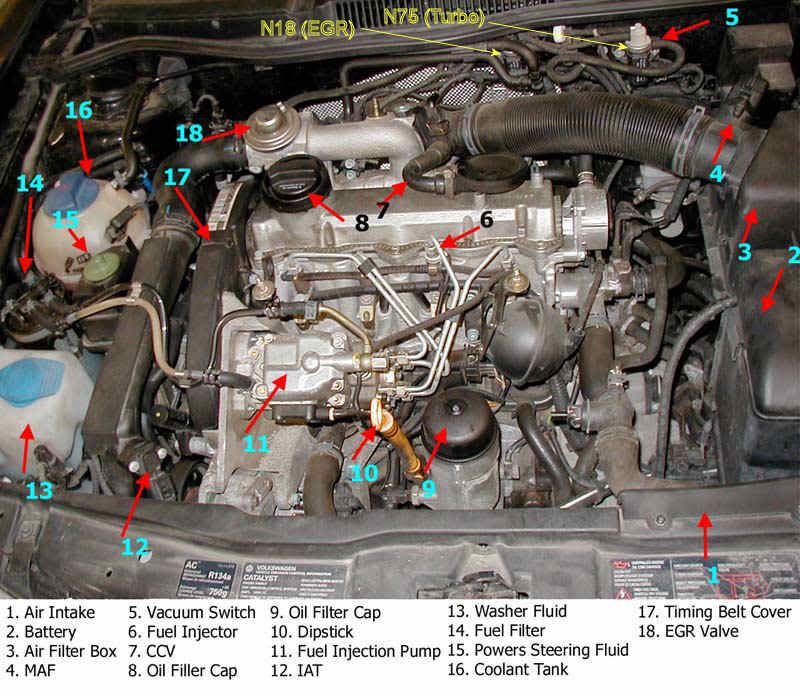
Downsides to disconnecting it. Well, the engine will now reach higher peak combustion temperatures, during the transient conditions that produce them, and generate a little NOx. The exhaust will be a little hotter during those times, so the turbine stage will get hotter. However, I think the temperatures are well within the allowable range for the engine components as I think the earliest TDI's had no EGR, California's paranoia having not reached out so far.
If you're worried about pollution, you will have modified the car out of compliance with one parameter, the NOx emissions. In the regulatory sense, this is not a problem as NOx is not tested at MOT time and is only regulated on the engines as manufactured. However, if a dealer notices it during service they will reconnect the EGR - they are obliged to, I think.
To counter this, EGR is the main reason that diesels still produce smoke - the ECU is able to control combustion well enough over most areas of operation to keep smoke generation at a minimum. So the use of EGR to regulate NOx results in an increase in particulate generation, another pollutant that is regulated.
There are many studies that point a finger at NOx as a smog precursor and ozone-depleter. I don't pretend to have read them all or be an expert, but what I've seen convinces me that the case is far from clear-cut and that NOx regulation on its own may well be counter-productive, allowing other pollutants to make the situation worse.
(boring bit follows)
Ozone formation at ground level is driven by NOx and VOC (Volatile Organic Compound) levels.
The principal source of reactive VOCs in the U.S. is the natural emission of isoprene from hardwood forests.
http://www.heartland.org/policybot/results/18973/EPA_Rule_Is_Making_Ozone_Smog_Worse.html
http://www-personal.umich.edu/~sillman/ozone.htm
http://books.nap.edu/openbook.php?record_id=1889&page=211
There is a case that NOx control is inappropriate, and that ozone formation is mainly due to the presence of low level of NOx in association with high levels of VOC's (in automotive terms, fuel and oil vapours). The obvious corollary is that NOx control is inappropriate (whether on motor vehicles or the biggest NOx generators, power plants) and that more attention should be paid to VOC control. Higher levels of NOx actually decrease ozone by a catalytic reaction.
http://books.nap.edu/openbook.php?record_id=1889&page=351
But in addition to that, the EGR valve itself can trigger limp mode, especially when the inlet is full of sticky gunk. Although you have now had it cleaned, disabling the EGR would eliminate this as a point of failure, and if you're lucky, fix the problem.
My first introduction to limp mode and EGR related failures was with a TDI 90 in a Mk.2 Ibiza. This has a wastegated turbo, so no vanes to stick. It would go into limp mode at motorway overtaking speeds, frustrating and potentially dangerous.
The EGR valve was sticking open, clogged with the sticky sludge resulting from hot sooty exhaust hitting oily crankcase vapours in the inlet charge. EGR is supposed to be closed at low revs, open in the midrange when the engine is loaded (ECU works all this out) and closed again at higher revs. When it fails to close, exhaust leaks past it and causes overpressure in the inlet, and the ECU triggers limp mode.
Disabling the EGR on our cars is really easy, just disconnect one electrical connector, the one to the N18 valve. Five minutes the first time you do it (find the right connector, work out how the damned things unlock, tie the loose end out of the way, wrap with duct tape to protect against dirt). Thirty seconds to reconnect for servicing. The valve is easy to find at the back of the engine bay.

Downsides to disconnecting it. Well, the engine will now reach higher peak combustion temperatures, during the transient conditions that produce them, and generate a little NOx. The exhaust will be a little hotter during those times, so the turbine stage will get hotter. However, I think the temperatures are well within the allowable range for the engine components as I think the earliest TDI's had no EGR, California's paranoia having not reached out so far.
If you're worried about pollution, you will have modified the car out of compliance with one parameter, the NOx emissions. In the regulatory sense, this is not a problem as NOx is not tested at MOT time and is only regulated on the engines as manufactured. However, if a dealer notices it during service they will reconnect the EGR - they are obliged to, I think.
To counter this, EGR is the main reason that diesels still produce smoke - the ECU is able to control combustion well enough over most areas of operation to keep smoke generation at a minimum. So the use of EGR to regulate NOx results in an increase in particulate generation, another pollutant that is regulated.
There are many studies that point a finger at NOx as a smog precursor and ozone-depleter. I don't pretend to have read them all or be an expert, but what I've seen convinces me that the case is far from clear-cut and that NOx regulation on its own may well be counter-productive, allowing other pollutants to make the situation worse.
(boring bit follows)
Ozone formation at ground level is driven by NOx and VOC (Volatile Organic Compound) levels.
The principal source of reactive VOCs in the U.S. is the natural emission of isoprene from hardwood forests.
http://www.heartland.org/policybot/results/18973/EPA_Rule_Is_Making_Ozone_Smog_Worse.html
http://www-personal.umich.edu/~sillman/ozone.htm
http://books.nap.edu/openbook.php?record_id=1889&page=211
There is a case that NOx control is inappropriate, and that ozone formation is mainly due to the presence of low level of NOx in association with high levels of VOC's (in automotive terms, fuel and oil vapours). The obvious corollary is that NOx control is inappropriate (whether on motor vehicles or the biggest NOx generators, power plants) and that more attention should be paid to VOC control. Higher levels of NOx actually decrease ozone by a catalytic reaction.
http://books.nap.edu/openbook.php?record_id=1889&page=351
Last edited:
welcome to the slippery slope
It is interesting what you say about the Innotec treatment as I have just done my ASV engine for the 2nd time. The treatment works but the life of the clean is not that great. This time when using it I worked the lever so many times my hands were aching. Before putting any liquid in the lever would not return, but as instructed, I put 25% in and the lever could then be operated fully. I have begun to think it is a lubricant!!.
After the full treatment gave the car a run and it went like a rocket, really impressed. On sunday went for a good run giving it plenty of revs, and tried to get any carbon left out of the system. My hopefull theory is that you need to give the car a long run not just a blast round the block to really get the system clear. Will have to wait and see if it lasts longer than before, when back on the commute.
As regards the ERG valve I have blanked mine off with a steel plate, but put 2mm hole in it as Skoda. Do NOT use an aluminium plate as this is attacked by the exhaust gases. Not noticed much difference and no messages, but inlet stays clean.
The CCV system is fully sealed and I would not just vent this. My next move is to fit a catch tank and filter to remove the oil from the mist.
I also wonder how much effect this oil back through the engine has on coking up the turbo, is there a link between oil use and limp mode.
sorry for length of post.
It is interesting what you say about the Innotec treatment as I have just done my ASV engine for the 2nd time. The treatment works but the life of the clean is not that great. This time when using it I worked the lever so many times my hands were aching. Before putting any liquid in the lever would not return, but as instructed, I put 25% in and the lever could then be operated fully. I have begun to think it is a lubricant!!.
After the full treatment gave the car a run and it went like a rocket, really impressed. On sunday went for a good run giving it plenty of revs, and tried to get any carbon left out of the system. My hopefull theory is that you need to give the car a long run not just a blast round the block to really get the system clear. Will have to wait and see if it lasts longer than before, when back on the commute.
As regards the ERG valve I have blanked mine off with a steel plate, but put 2mm hole in it as Skoda. Do NOT use an aluminium plate as this is attacked by the exhaust gases. Not noticed much difference and no messages, but inlet stays clean.
The CCV system is fully sealed and I would not just vent this. My next move is to fit a catch tank and filter to remove the oil from the mist.
I also wonder how much effect this oil back through the engine has on coking up the turbo, is there a link between oil use and limp mode.
sorry for length of post.
The CCV shouldnt have much effect on the turbo tbh, there is so little going in compared to the air/fuel, it just gets burned straight away, its the the fact it has so many places to land and collect on, (all intake pipe-work, compressor side of the turbo, intercooler ect).
The sludge that comes from the EGR and inlet manifold is the combination of the CCV fumes and soot coming together to make a sticky oily paste which is tough to remove once its in-gained.
The sludge that comes from the EGR and inlet manifold is the combination of the CCV fumes and soot coming together to make a sticky oily paste which is tough to remove once its in-gained.
teds1969 wrote
many thanks for detailed reply. Have located the electrical connection in the engine bay. Whats the trick in disconnecting it as i cannot budge it.
I have had some difficulty undoing other connectors under the bonnet, and found that there is a locking catch that must be disengaged by pulling the tab backwards, in the direction of pulling the connector apart.
I've used the connector onto the brake fluid level sensor in the following photo's, because it's easy to get to.
The plug looks like this, end-on, when it's apart.
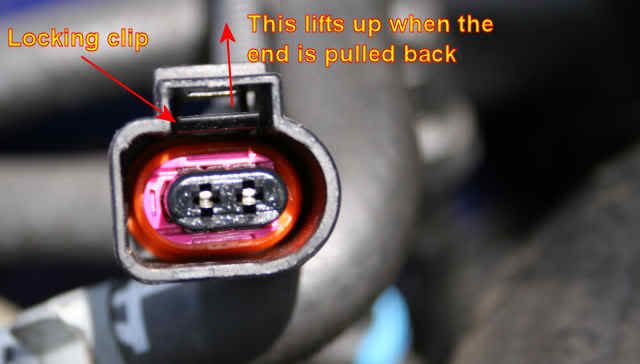
The socket is shown here, with the locking tab
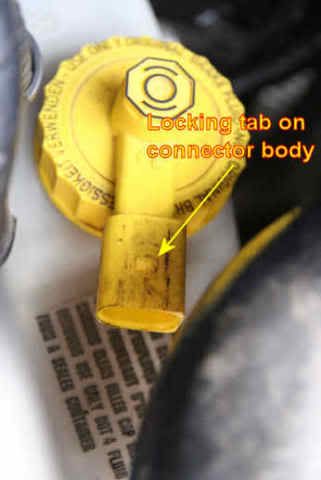
Here is a top view of the connector plug showing where the bit you pull on is located.
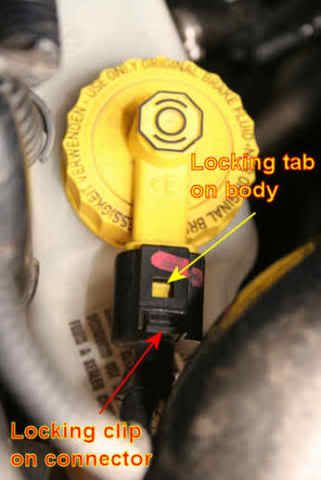
This is how it comes apart.
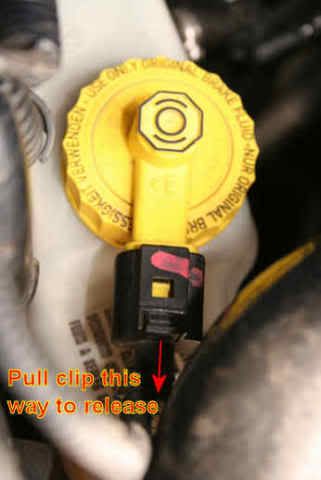
Hope this helps
many thanks for detailed reply. Have located the electrical connection in the engine bay. Whats the trick in disconnecting it as i cannot budge it.
I have had some difficulty undoing other connectors under the bonnet, and found that there is a locking catch that must be disengaged by pulling the tab backwards, in the direction of pulling the connector apart.
I've used the connector onto the brake fluid level sensor in the following photo's, because it's easy to get to.
The plug looks like this, end-on, when it's apart.

The socket is shown here, with the locking tab

Here is a top view of the connector plug showing where the bit you pull on is located.

This is how it comes apart.

Hope this helps
Just disconnected mine, the connector is simple to open if you follow Muttley's helpful pictures. I will be interested to see how it goes, as I've been getting some smoke recently, especially when accelerating hard through the lower gears. This is despite constant use of V power diesel and Miller's.
Disconnecting EGR connector
Oh dear, this did not work for me. Just back from a 35 mile journey, the engine management light came on immediately and the car went in to limp mode soon after. Re-starting only worked for a while then limp mode again. The car is a 110 TDI non PD, '04 model.
Oh dear, this did not work for me. Just back from a 35 mile journey, the engine management light came on immediately and the car went in to limp mode soon after. Re-starting only worked for a while then limp mode again. The car is a 110 TDI non PD, '04 model.
Sorry to hear that my advice wasn't good for you. Can only say it works for me. You have disconnected N18 and not N75, I hope?
What engine do you have, ASV?
Limp mode should never happen for EGR disconnection, lack of EGR does not put engine in danger.
What engine do you have, ASV?
Limp mode should never happen for EGR disconnection, lack of EGR does not put engine in danger.
Just re-connected it, been out and done a few re-starts and the management light has now gone out again. Yes I too was surprised by the car's reaction, as it's the same ASV engine and it was definitely the N18 connector, I did not touch the N75. Maybe mine has a different type of ECU. It was worth a try anyway!
Similar threads
- Replies
- 9
- Views
- 1K


 I need a re-map....
I need a re-map....